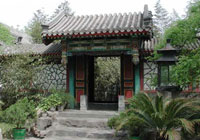Prince Gong's Mansion is located near Shichahai Lake, to the
northwest of the Forbidden City in Beijing. The private residence
of He Shen, a favorite minister of Emperor Qianlong of the Qing
Dynasty (1644-1911), it was built in 1777. In 1851, the mansion was
bestowed upon Prince Gong by Emperor Xianfeng (1851-1862), hence
the name. Sole prince's mansion open to the public, it is the most
well preserved mansion in Beijing.
Two stone lions guard the main gate, and magnificent buildings
stand to the fore of the mansion, with an elegant garden at the
rear. On the wall of the main hall hangs a plaque inscribed with
three characters "Bao Guang Shi" in the calligraphy of Emperor
Xianfeng.
The buildings at the forefront of the mansion are on three axes,
and apart from a two-story building consisting of ninety-nine and
half rooms, all are in traditional style. Duofu Study is on the
eastern axis, and its structure is in the Ming style. On each of
the two side axes are four courtyards, the second courtyard on the
western axis being strikingly spacious. In the third courtyard,
called Xijin Studio, there is a seven-roomed, exquisitely furnished
hall. All the beams and pillars are made of nanmu, and its
sandalwood partitions are reminiscent of those found in Ningshou
Palace in the Forbidden City. Between the buildings and the rear
garden there stands a 165-meter-long two-story building.
 |
The garden in Prince Gong's Mansion is named Cuijin, meaning
concentrated cream of the most beautiful flowers, and to this day
it lives up to its name. The garden covers 28,000 square meters,
and is surrounded by man-made hills on four sides. The main peak,
constructed from Taihu rocks, is in the north. The garden has an
arched stone gate in typical Western architectural style, and upon
entering the garden, one can see the five-meter high Dule Peak,
which is a rock procured from Lake Tai in southern China. Behind it
is the Bat Pond (Bat is a homonym of happiness in Chinese). Beyond
the pond stands the Anshan Hall and opposite, at the center of the
garden, is a hill bearing a stone tablet inscribed with the Chinese
character "fu" (happiness) in the calligraphy of Emperor Kangxi
(1662-1723). Behind the hill are masterpieces of garden
architecture, with more than 20 scenic spots. In addition to its
artificial hill, trees, flowers, pavilions and terraces, the garden
also contains the unique feature of its own theater.
 |
This theater is lofty and spacious, with subtle lighting, and on
its walls Chinese wisteria and green leaves are painted, giving the
audience the feeling they are sitting beneath trellises. The floor
is paved in pseudo-gold brick, and the seats consist of
old-fashioned wooden armchairs furnished with square tables. The
performers and the audience are in close proximity, so there is no
need for audio amplifying equipment. Here, people can enjoy kunqu,
Peking Opera and imperial music, a unique experience full of Qing
historical significance.
To help visitors gain a better understanding of the culture
attaching to the mansion, the administration of Prince Gong's
Mansion has converted Bat Hall into a teahouse. The visitors'
program includes a full tour of the mansion, tea drinking,
observing the exquisite art of the tea ceremony, sampling Beijing
style titbits, and enjoying folklore performances, all of which
evoke an enthusiastic response. There is also an exhibition of the
history of the Qing Dynasty, including replicas and photos of
cultural relics. The exhibits date from 1616, when the Qing Dynasty
was founded, to 1912, when the last emperor, Puyi, abdicated.
Travel tips:
Address: A14, Liuyin Street, Xicheng District, Beijing. Take
Trolley Bus 111, 107, or 108 and Bus 13, 107, 111, 701, or 823, and
get off at Beihai Houmen stop.
Openning hours:? 8:30?- 17:00?
Admission: 20 yuan; 60 yuan including folk art performance and
snack.
Tel: 8610-66116053
(China.org.cn?June 6, 2007)